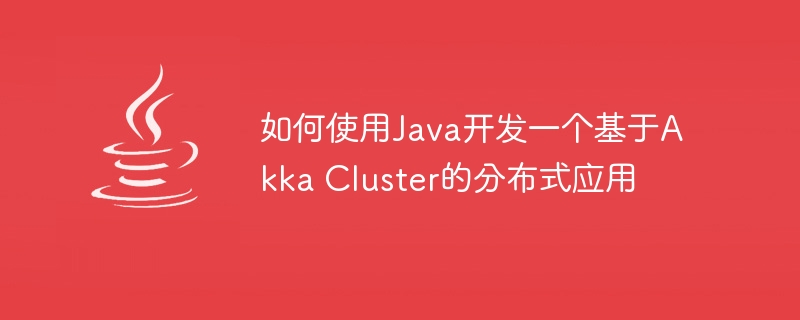

How to use Java to develop a distributed application based on Akka Cluster
Introduction:
With the development of cloud computing and big data, the demand for distributed applications more and more important. Akka Cluster is a distributed computing solution based on the Akka framework, which provides an easy way to develop and deploy distributed applications. This article will introduce how to use Java to develop a distributed application based on Akka Cluster and provide specific code examples.
1. Prerequisites:
Before you start, you need to do some preparations:
2. Create a basic project:
Before starting the real development, we need to create a basic project, including the following files and folders:
<groupId>com.typesafe.akka</groupId> <artifactId>akka-actor_2.12</artifactId> <version>2.5.25</version>
<groupId>com.typesafe.akka</groupId> <artifactId>akka-cluster_2.12</artifactId> <version>2.5.25</version>
Then, create the following Java source code files in the src/main/java folder:
import akka.actor.AbstractActor;
import akka.actor.ActorRef;
import akka.actor.ActorSelection;
import akka.actor.ActorSystem;
import akka.actor.Props ;
import akka.cluster.Cluster;
import akka.cluster.ClusterEvent;
import akka.cluster.ClusterEvent.MemberJoined;
import akka.cluster.ClusterEvent.MemberUp;
import akka .cluster.ClusterEvent.MemberRemoved;
import akka.cluster.ClusterEvent.MemberEvent;
import akka.japi.pf.ReceiveBuilder;
public class Main {
public static void main(String [] args) {
ActorSystem system = ActorSystem.create("cluster-system");
ActorRef master = system.actorOf(Props.create(MasterActor.class), "master");
ActorRef worker1 = system.actorOf(Props.create(WorkerActor.class), "worker1");
ActorRef worker2 = system.actorOf(Props.create(WorkerActor.class), "worker2");}
}
public class MasterActor extends AbstractActor {
private Cluster cluster = Cluster.get(getContext().getSystem());
public MasterActor() {
cluster.subscribe(getSelf(), ClusterEvent.MemberEvent.class);
}
public static Props props() {
return Props.create(MasterActor.class);
}
@Override
public Receive createReceive () {
return ReceiveBuilder.create()
.match(MemberUp.class, mUp -> {
System.out.println("Member is Up: " + mUp.member());
})
.match(MemberJoined.class, mJoined -> {
System.out.println("Member joined: " + mJoined.member());
})
.match(MemberRemoved.class, mRemoved -> {
System.out.println("Member is Removed: " + mRemoved.member());
})
.match(MemberEvent.class, message -> {
// handle other member events
})
.build();}
}
public class WorkerActor extends AbstractActor {
@Override
public Receive createReceive() {
return ReceiveBuilder.create()
.matchAny(message -> System.out.println("Received message: " + message))
.build();}
}
3. Run distributed applications:
Now that we have created a basic Akka Cluster project, we need to run the application to test its distributed functionality. First, we need to start three independent Java processes to simulate the Master and Worker nodes in the cluster.
In the console, run the following commands respectively:
java -jar
java -jar
java -jar
Where, your_project_folder is your project folder path, your_project_name is your project name.
When the three Java processes are started, you will see some output information, including the creation of Master Actor and Worker Actor, node information added to the cluster, etc.
4. Conclusion:
This article introduces how to use Java to develop a distributed application based on Akka Cluster, and provides actual code examples. Akka Cluster can be used to easily develop and deploy distributed applications. It provides scalability and fault tolerance, and can effectively handle large-scale concurrent and distributed tasks. I hope this article provides you with a basic understanding of Akka Cluster and helps you start building your own distributed applications.
The above is the detailed content of How to use Java to develop a distributed application based on Akka Cluster. For more information, please follow other related articles on the PHP Chinese website!
